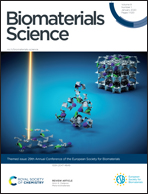The fabrication of a highly efficient self-healing hydrogel from natural biopolymers loaded with exosomes for the synergistic promotion of severe wound healing†
Abstract
Unhealable diabetic wounds and disabling scar formation in severe wounds need to be addressed with the help of multiple techniques. Here we put forward an idea to use exosomes loaded into a supporting scaffold to rebuild the vascular transportation system, which could solve hypoxia and infertility in these wounds. A highly efficient self-healing and biocompatible natural-based methylcellulose-chitosan hydrogel loaded with biological exosome nanoparticles has the appropriate strength and is made by an easy preparation process, and it eventually achieves the integrated structure needed for healing severe diabetic conditions. Hydrogels perform well in the cell proliferation and skin remodeling stages because of their three-dimensional porous structure, and self-healing and adhesion properties. Also, exosomes accumulated to an effective concentration for a period of time could induce proliferation, especially relating to vascular formation. After the overpass (vascular) has been constructed with the help of the base (hydrogel) and workers (exosomes), the society (skin) is reconstructed under a system of supply and regulation. The research results indicate that these novel complex hydrogels loaded with exosomes provide wide prospects for the healing of severe wounds.



 Please wait while we load your content...
Please wait while we load your content...